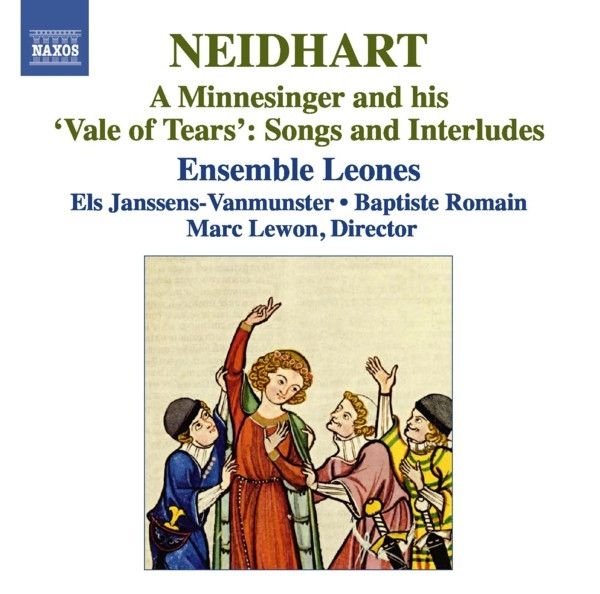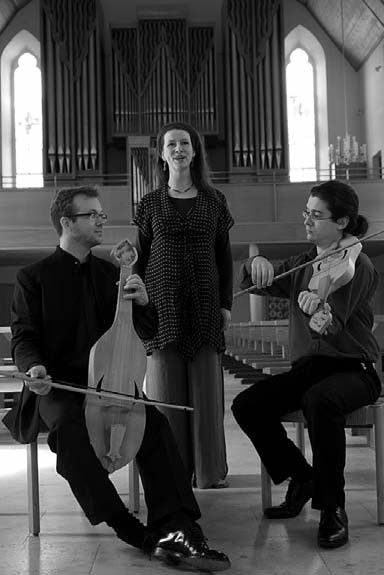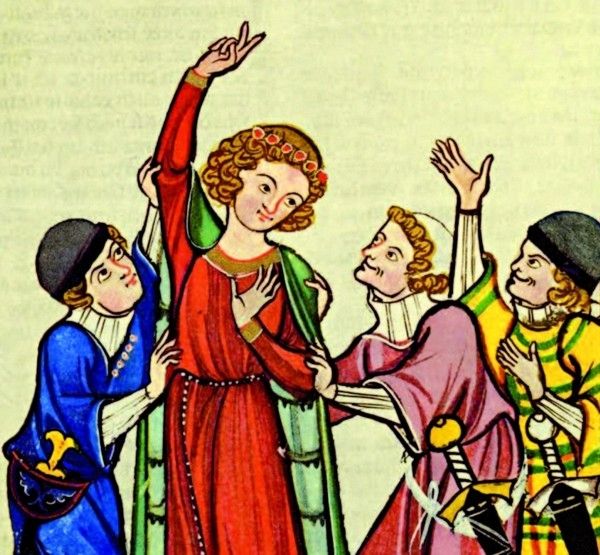Neidhart, c.1185-c.1240 / Ensemble Leones
A Minnesinger and his ‘Vale of Tears’ · Songs and Interludes

medieval.org
naxos.com
leones.de
musicweb-international.com
Naxos 8.572449
2012
01 - cantilena ‘Der
han’ [2:34]
‘The cock’
music: Neidhart, arr. B. Romain
bagpipes
02 - Mir ist
ummaten leyde [5:27]
I am grieved beyond all measure
music and text: Neidhart, arr. M. Lewon
Marc Lewon · 2 vielles
03 - Summer unde
winder [7:45]
Summer and winter
music and text: Neidhart, arr. M. Lewon
Els Janssens-Vanmunster · vielle
04 - clausula
[3:54]
arr. B. Romain – material taken from several Neidhart songs
and 13th century English monodies
gittern · vielle
05 - [7:39]
Sinc eyn gulden hoen
Sing, you golden hen
music and text: Neidhart, arr. M. Lewon
stantipes ‘Der munich’
‘The
monk’
music: Neidhart, arr. B. Romain
Marc Lewon · vielle
06 - Willekome eyn
sommerweter suze [5:54]
Welcome the sweet summer weather
music and text: Neidhart, arr. M. Lewon
Els Janssens-Vanmunster · gittern,
vielle
07 - Guoten wib wol
üch der eren [5:48]
Gracious ladies, you deserve honour
text: Der tugendhafte Schreiber (fl.1208-1228), contrafacture and
arrangement by M. Lewon
melody adapted from the Jenaer Liederhandschrift (14th century)
Marc Lewon · 2 vielles
08 - muteta ‘Non
veul mari’ [1:48]
‘I do not want a husband’
arr. B. Romain – material taken from a 13th-century motet
2 vielles
09 - Ich claghe de
blomen [9:28]
I mourn for the flowers
music and text: Neidhart, arr. M. Lewon
Els Janssens-Vanmunster
10 - stantipes ‘Der
hedamerschol’ [2:31]
‘The hedamerschol’
arr. B. Romain – material taken from a 13th-century motet tenor
lute · bagpipes
11 - Allez daz den
sumer [7:03]
Everything that all summer long
music and text: Neidhart, arr. M. Lewon
melody taken from the Riedsche Handschrift
Marc Lewon · lute
12 - Vil wol
gelopter got [3:13]
God, so highly extolled
music and text: Walther von der Vogelweide
Els Janssens-Vanmunster · 2
vielles
Bonus track
13 - Je muir, je
muir [1:36]
I die, I die
music and text: Adam de la Halle (c.1237-1288), arr. M. Lewon
Els Janssens-Vanmunster, Marc Lewon,
Baptiste Romain

ENSEMBLE LEONES
Marc Lewon
Marc Lewon
voice 2 5 7 11 13
plectrum-lute 10 11 · Stephen Gottlieb, 2001
gittern 4 6 · George Stevens, 2004
German vielle 2 7 8 12 · Stepan Tyhonenko, 1998
Els Janssens-Vanmunster, voice 3 6 9 12 13
Baptiste Romain
vielles 2-8 12 · Judith Kraft, 2007 / Roland Suits, 2006
bagpipes 1 10 · Robert Matta, 2009
voice 13
Recorded at Heilig Kreuz Kirche, Binningen, Switzerland, from 6th-9th
April, 2010
Producer: Marc Lewon • Engineer and editor: Félix Stricker
Batista
Booklet notes and translations: Marc Lewon
Cover: Neidhart forced by armed peasants to make an oath,
from the Große Heidelberger Liederhandschrift (Codex Manesse),
courtesy of the Universitätsbibliothek Heidelberg, Germany

Neidhart
(c.1185-c.1240)
A Minnesinger and
his ‘Vale of Tears’: Songs and Interludes
Neidhart, who owing to a nineteenth-century misapprehension is
sometimes still wrongly referred to as “von Reuental” (i.e.
“from the Vale of Tears”), was one of the most popular
Minnesingers of the late Middle Ages, even though (or more likely
“because”) his songs mainly parodied classical Minnesang
topics rather than serving them. From this was coined the name that his
genre of songs is known by in modern scholarship: Gegensang
(Anti-Minnesang). While his contemporary colleagues, the troubadours
and other Minnesingers, propagated the ideals of courtly love, Neidhart
turned the established order of how to present this topic on its head.
He transferred the settings of his poems from courtly realms into an
apparently rustic milieu, his central characters not comprising nobles,
but peasants – or so it would seem. By using this device of
changing the scenery to something so obviously inappropriate, he
cunningly opened up a multitude of layers of meaning. Superficially, he
turned a serious matter into something hilarious, thus entertaining his
audience in an unexpected way, while in his songs village-simpletons
try to succeed in the tricky realms of courtly love and, of course,
fail. Furthermore, he provides sex and crime through erotic or even
obscene incidents, funny arguments between mother and daughter about
who gets to go out with the dashing knight, as well as churlish brawls
or even outright violent fights between protagonists. Hidden underneath
these layers, in the background, however, Neidhart offers severe
criticism of the privileged classes of medieval society. The
antagonists of his songs, the rural simpletons, he names “dörper”,
which can be translated as “village dwellers” or peasants
(and can be seen as the German counterpart of the French “vilain”,
which literally means “village dweller”, but which
obviously translates as “villain”). However, with closer
inspection they are not what they seem at first sight. In employing a
Low German term Neidhart had artfully coined a new word in his Bavarian
sphere that he used as a cipher or code for something else entirely;
with his songs he meant actually to address the in-crowd at court
themselves, the audience of his songs – courtiers who overdress,
behave pretentiously, and act against the virtues of moderation that
should govern the noble classes. Many a listener may have choked on
their own laughter when thinking about the texts. Neidhart only played
the fool and rather held up a mirror to his audience.
Furthermore, Neidhart tended to classify his songs into
“summer” and “winter” songs, according to which
season he employed in the Natureingang (nature introduction)
that opens nearly every song. Here he establishes an emotional backdrop
for the lyrics: “Winter” symbolizes a melancholic
atmosphere and is well suited to introducing topics that strongly refer
to classical Minnesang, while descriptions of the approaching
summertime are generally used for lighter subjects, often containing
dance descriptions.
These various ingredients made a winning combination in
Neidhart’s works. His songs were popular enough to survive him by
far and his œuvre and style of writing was transmitted in
numerous manuscripts for the next 200 years. “A Neidhart”
would come to be known as a generic term for his style and in late
sources it is hardly distinguishable which parts were written by the
“original Neidhart” and which were adaptions “in the
style of Neidhart”. In fact it does not really matter. The
reality is that the corpus of songs transmitted under the name of
“Neidhart” is a treasure trove to us, because the music
associated with his name is the best documented among the Minnesingers.
The fragmentary manuscript which recording represents the earliest
transmission of Neidhart melodies and is arguably the earliest source
for music of German Minnesang in general.
The Frankfurt Neidhart-Fragment (Frankfurt/Main, University
Library, Ms. germ. oct. 18 — dated to c.1300), one of the rare
sources of music for Minnesang, comprises eight partly damaged
pages of an originally larger manuscript, transmitting the remains of
six Neidhart songs, of which five survive with melodies more or less
intact. Owing to its poor state and its rather small compass this
fragment was never counted among the major sources for Neidhart’s
œuvre. It is probably as a result of some bad press surrounding
the manuscript’s scribe, however, that it has been neglected by
scholars and performers alike. Only later was the value of this musical
source acknowledged, but never has it been recorded or performed as a
whole even though the melodies prove to be of great beauty and high
musical quality. The manuscript was written in Low German regions
– a feature that it shares with most of the other rare examples
of musical transmission of Minnesang – so that the
originally Middle High German texts are presented here in a “Low
Germanised” version; a version that is neither truly Middle High
German nor Middle Low German. This might have been a further factor
contributing to the manuscript’s low prestige. Another
distinctive feature of this source is its apparent proximity to actual
performance. Corrections in the music and melodic variations in
written-out repetitions provide vital clues as to how singers of the
late thirteenth century dealt with such monophonic pieces.
The fragmentary nature of the source puts major obstacles in the way of
a performance from the original. Thus, before actually working on the
music a playable edition had to be produced from the surviving
material. On the basis of some photography commissioned with the
Frankfurt University Library a new transcription was made, the careful
analysis of which helped find a playable version for all the songs.
Comparison with concordances was used to fill in the gaps in a
meaningful way in order to establish a complete version of music and
text. The results and findings of this analysis and reconstruction were
employed for the present recording and are to be published with the Verlag
der Spielleute (Reichelsheim/Germany) as the opening volume of a
new series of editions on medieval music. It contains the first
complete colour facsimile of the original source, a line-by-line
transcription, and a playable edition with an extensive commentary in
German and English to make this significant musical source available to
scholars and performers.
The present CD is the first recording of the Frankfurt
Neidhart-Fragment in its current state, not only featuring all its
melodies but also all its lyrics in the exact reading of the source.
All Neidhart songs on this recording were taken from the said
manuscript. Even though the source is only a fragment of a once larger
manuscript and in its piecemeal state cannot have constituted a
coherent performance repertoire, the surviving songs nonetheless form a
well-balanced and varied programme. They show the distinctive
trademarks of Neidhart’s œuvre and touch on many aspects of
his lyrical portfolio, featuring content, form, and musical modes
typical to his work: “Sinc eyn gulden hoen” [5] and
“Willekome eyn sommerweter suze” [6] represent the
genre of light dance songs. “Mir ist ummaten leyde”
[2] and “Summer unde winder” [3] are two very
typical Neidhart songs that start out as almost classic Minnesang
with the characteristic 180 degree turn to “dörper”
topics after the first couple of strophes. “Allez daz den sumer”
[11] and “Ich claghe de blomen” [9] stand for the
grand love-lament that dwells on didactic and philosophical reflections
about courtly love. The latter piece, which also features the most
sweeping of all melodies within the source exhibiting a compass of
almost two octaves, grants one a rare glimpse into the requirements of
a professional singer of the time: the final strophe is a request for
abatement of taxes. And even though in this source the above-mentioned
“winter songs” prevail, the fragment contains at least one
clear “summer song”.
Two examples of Minnesang by Neidhart’s contemporaries
keep company with his pieces in the recording: “Guoten wib wol
üch der eren” [7] by “Der tugendhafte
Schreiber” (i.e. “the virtuous scribe”, a pseudonym)
– one of the participants of the legendary Contest of Song on
the Wartburg – provides classical Minnesang in its pure form
as a contrast and backdrop for Neidhart’s modifications. Since
the song is transmitted without its melody, a suitable tune was adapted
from another Minnesang transmitted in the fourteenth-century Jenaer
Liederhandschrift. “Vil wol gelopter got” [2] by
the famous Walther von der Vogelweide – possibly a rival of
Neidhart’s and likewise a fellow campaigner in the Wartburg
Song Contest — only survives with a fragmentary melody. It
concludes the programme thematically and musically and with a
substitution of its missing middle part is – like “Guoten
wib” – first recorded here.
The three-voice “Je muir, je muir” [13] by Adam de
la Halle is thought of as an encore to the programme, giving an outlook
on an age of polyphonic song-writing that already blossomed in France
but from which the German Minnesang of Neidhart’s time
was yet but far.
Because of their often rustic, erotic and violent content as well as
the frequent occurrence of dance topics in Neidhart’s songs, they
are nowadays commonly interpreted in a churlish, folk-like fashion with
an emphasis on rhythm, percussion, and large orchestration — much
as people generally assume pub songs and peasant dances must have
sounded. (Since no music of these classes survives from the Middle
Ages, however, this assumption of course also stays within the realm of
speculation.) Nevertheless, Neidhart’s œuvre is —
just as classic Minnesang — part of the court culture and
has nothing to do with peasant music. On the contrary, his songs lived
through being comparable to the high art of his colleagues and by
treating it ironically. Thus at least for the early transmission of
Neidhart songs such as in the Frankfurt Fragment, there is
nothing to suggest that his songs should be approached differently from
how we assume other repertories of courtly love song were interpreted.
The world invoked in Neidhart’s songs is an illusory world, a
stage so to speak, with rustic elements only serving as allusions,
specifically employed to generate certain effects. In a sense
Neidhart’s œuvre could be compared to the Baroque love for
shepherds’ idylls, which also only quotes bucolic elements to
stylise and idealise them. The songs from the early Neidhart sources
are therefore much more indebted to irony than to horseplay.
Consequently, Ensemble Leones only quotes the rustic milieu and shifts
these quotations mainly to the instrumental accompaniment and the
instrumental pieces. The singers approach the pieces via an intensive
declamation of the texts and by superimposing subtle shades of irony on
their interpretations where suitable, without trying to make peasant
music out of Neidhart’s songs.
The instrumentation and composition of the ensemble reflects the
aforementioned insights. Just as in classic Minnesang, Leones
adopts a small instrumentation, with the songs interpreted either
soloistically a cappella (“Ich claghe de blomen”),
or with the singer accompanying himself (“Allez daz den sumer”),
or accompanied by either one instrument (“Summer unde winder”
and “Sinc eyn gulden hoen”) or two (“Mir
ist ummaten leyde”, “Willekome eyn sommerweter”,
“Guoten wib wol üch der eren” and “Vil
wol gelopter got”), with the vielle (fiddle) serving as the
main accompanying instrument.
The instrumental pieces of the programme were borrowed from
contemporary compositions or other Neidhart sources and especially
arranged for this recording. They act as “dividers” between
the songs and carry a discreet rural flavour, conveyed through
rhythmic, dancelike elements and the use of instruments such as the
bagpipes. In doing so, however, they still never entirely leave the
courtly domain.
Marc Lewon




